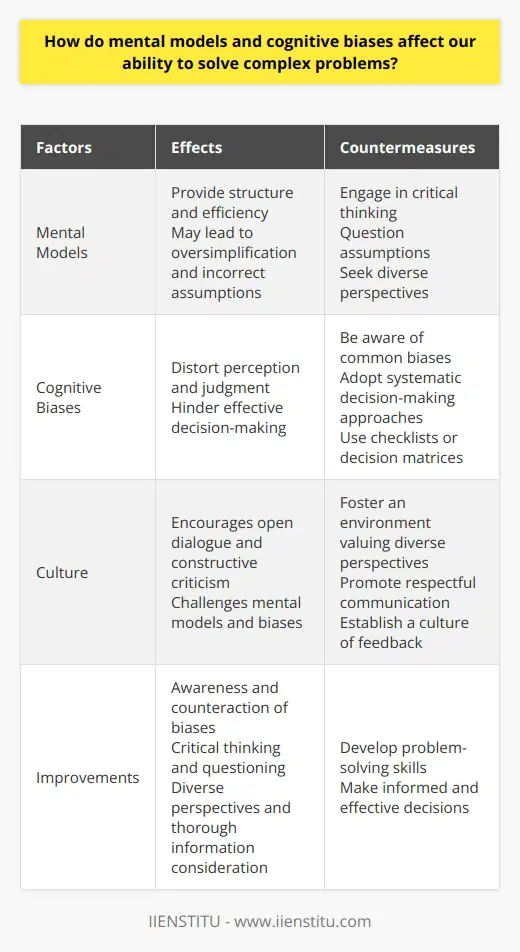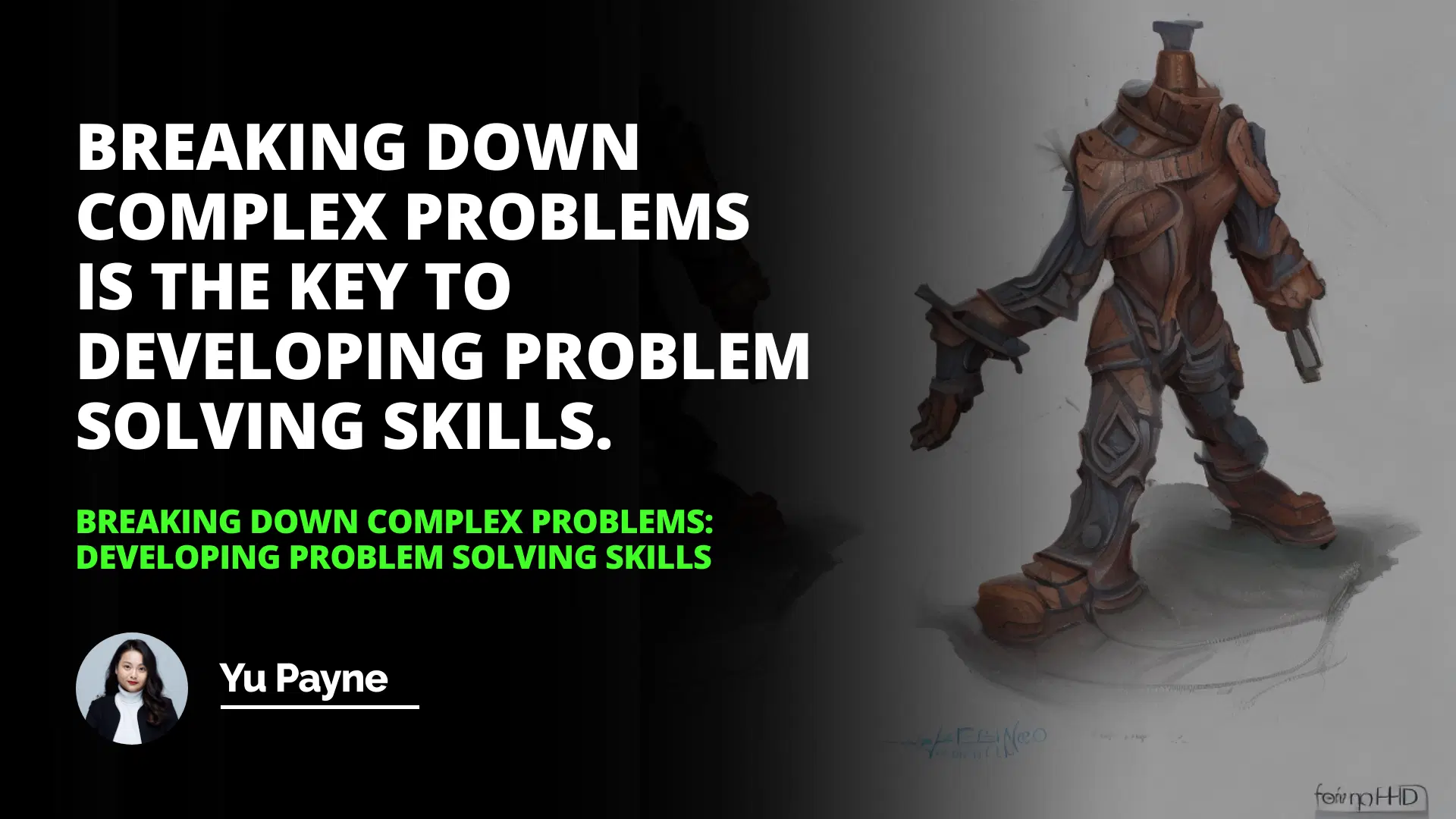
Several strategies can be used to break down complex problems, such as starting with the end goal in mind and working backward, breaking the problem down into smaller, more manageable pieces, and identifying the steps that need to be taken to reach the desired outcome. Examples of breaking down complex issues include math problems and business problems. This article discussed the benefits of breaking down complex issues and strategies for breaking down complex topics and provided examples.
Introduction
Benefits of Breaking Down Complex Problems
Strategies for Breaking Down Complex Problems
Examples of Breaking Down Complex Problems
Conclusion
Introduction: Breaking complex problems into smaller, more manageable parts is crucial for successful problem-solving. By breaking down a problem into smaller steps, problem solvers can more easily identify the underlying causes of pain and develop a plan of action. This article will discuss the benefits of breaking down complex issues, strategies for breaking down complex issues, and provide examples of breaking down complex problems.
Benefits of Breaking Down Complex Problems
Breaking complex problems into smaller, more manageable parts can provide several benefits. First, it can help to clarify the situation, making it easier to identify the underlying causes and develop a plan of action. Breaking down a problem can also help reduce stress, as it allows the problem solver to focus on a tiny part of the problem at a time rather than tackling the issue as a whole. Finally, breaking down a problem can help to increase the efficiency of the problem-solving process, as it allows the problem solver to focus on a tiny part of the problem at a time rather than trying to tackle the issue as a whole.
Strategies for Breaking Down Complex Problems
Several strategies can be used to break down complex problems. One method is to start with the end goal in mind and work backward. This can help identify the steps that need to be taken to reach the desired outcome. Another strategy is to break the problem into smaller, more manageable pieces. This can help identify the problem's underlying causes and develop a plan of action. Finally, it can be helpful to break the problem down into smaller, more manageable pieces and then identify the steps needed to reach the desired outcome.
Examples of Breaking Down Complex Problems
One example of breaking down a complex problem is a math problem. By breaking down a math problem into smaller, more manageable pieces, it can be easier to identify the underlying causes of the pain and develop a plan of action. For example, if a math problem involves solving for x, the problem solver can start by looking at the equation and identifying the steps needed to solve for x. This could include breaking the equation into smaller pieces and then cracking for x one step at a time.
Root Cause Tree Analysis: Insights to Forensic Decision Making
Pareto Chart: A Powerful Tool for Data Analysis and Decision-Making
Another example of breaking down a complex problem is a business problem. By breaking down a business problem into smaller, more manageable pieces, it can be easier to identify the underlying causes of the pain and develop a plan of action. For example, suppose a business problem involves increasing sales. In that case, the problem solver can start by looking at the current sales process and identifying the steps that need to be taken to increase sales. This could involve breaking the sales process into smaller pieces and increasing sales one step at a time.
Conclusion: In conclusion, breaking complex problems into smaller, more manageable parts is a crucial skill for successful problem-solving. By breaking down a problem into smaller steps, problem solvers can more easily identify the underlying causes of pain and develop a plan of action. Several strategies can be used to break down complex problems, such as starting with the end goal in mind and working backward or breaking the problem down into smaller, more manageable pieces. Examples of breaking down complex issues include math problems and business problems. By breaking down complex problems, problem solvers can more easily identify the underlying causes of pain and develop a plan of action.
Breaking down complex problems is the key to developing problem-solving skills.
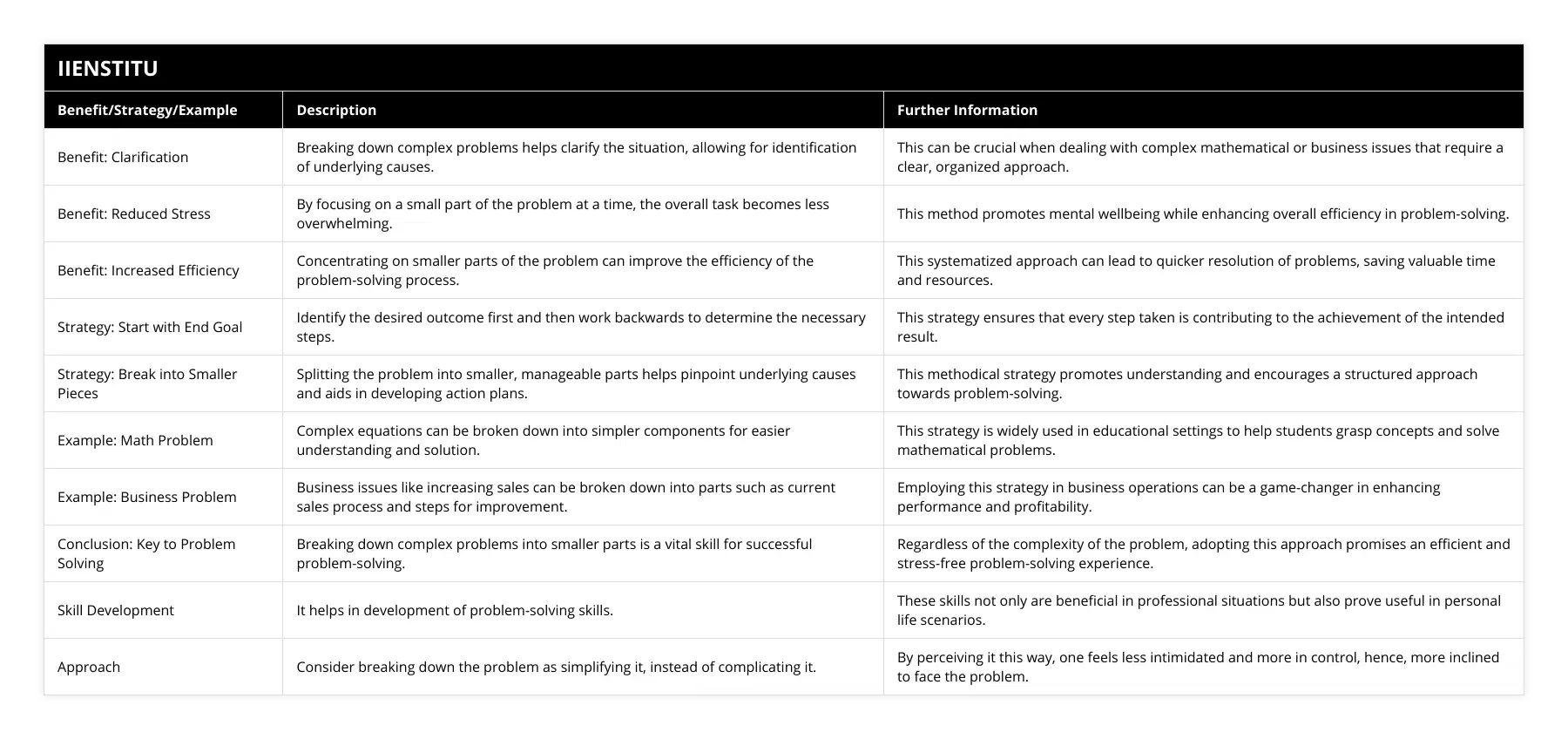
Frequently Asked Questions
What are the benefits of breaking down complex problems?
When faced with a complex problem, it cannot be easy to know how to approach it. However, breaking down complex problems into smaller, more manageable chunks can effectively tackle them. This article will explore the benefits of breaking down complex issues.
First, breaking complex problems into smaller components can make them easier to understand and conceptualize. By breaking down a problem into smaller pieces, we can more easily identify the individual members and know how they interact. This can help us to identify potential solutions and develop strategies to address the problem effectively.
Additionally, breaking down complex problems can help to prevent us from becoming overwhelmed. A difficult situation can be daunting, and breaking it down into smaller parts can make it more manageable and easier to approach. This can help reduce stress and anxiety, allowing us to focus more easily on the task.
Finally, breaking down a complex problem can help to identify areas where further research or investigation is needed. We can better identify areas requiring further exploration or experimentation by breaking down the problem into its components. This can help ensure that we take a thorough approach to the problem.
In conclusion, breaking down complex problems can be an effective way of tackling them. By breaking down the problem into smaller parts, we can more easily identify its components and understand how they interact. This can make the problem easier to understand and conceptualize, reduce stress and anxiety, and help to identify areas where further research or investigation is needed.
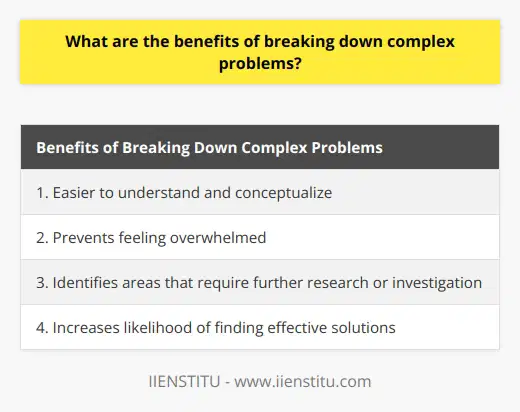
What strategies can be used to break down complex problems?
When faced with a complex problem, it can be challenging to break it down into more manageable parts. However, it is essential to break down complex issues to understand them better and develop solutions. Here are some strategies that can be used to break down complex issues:
Start with the big picture. First, it is essential to understand the overall problem before attempting to break it down. This can be done by looking at the problem from a high-level perspective and considering all of the elements that are involved.
Identify the key components. Once the big picture has been identified, it is essential to identify the critical elements of the problem. This can be done by looking at the situation and breaking it into its components.
Analyze each component. Once the key features have been identified, it is essential to analyze each element in detail. This can be done by looking at the individual members of the problem and considering how they interact and contribute to the overall situation.
Break down further. Once a thorough analysis of each component has been done, it is essential to break down each part further. This can be done by looking at the individual elements of each member and breaking them down into smaller pieces. Doing this can help to identify any underlying issues that may be contributing to the overall problem.
Develop solutions. Once a thorough analysis of the problem is done, developing solutions is essential. This can be done by looking at the individual components of the problem and identifying potential solutions that could address the issues that have been identified.
Using these strategies makes it possible to break down complex problems into more manageable parts. This can be beneficial in terms of understanding the problem and developing solutions that can be implemented.
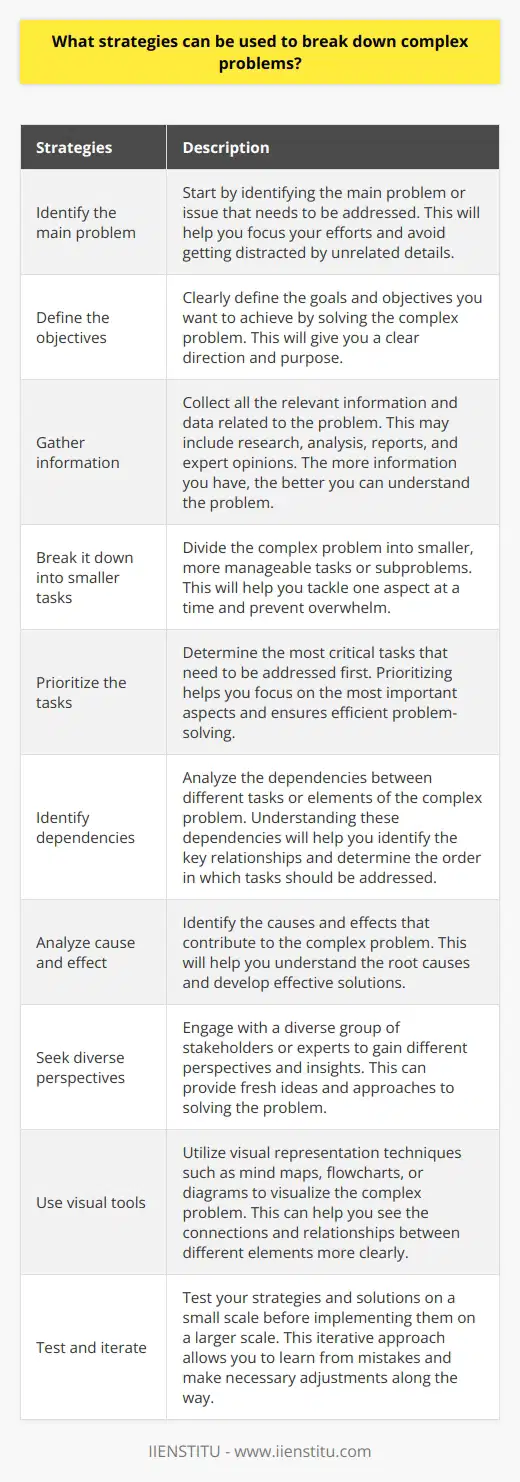
What are some examples of breaking down complex problems?
When attempting to solve a complex problem, it is important to break it down into smaller, more manageable pieces. Breaking down a complex problem can help identify the issue's individual components and make it easier to devise a solution. Several strategies can be used to break down a complex problem, including the following:
Identifying the Goals: The first step in breaking down a complex problem is determining the end goal or the desired outcome. This will help to narrow the focus of the problem and make it easier to identify the individual elements that need to be addressed.
Identifying Key Factors: Once the goal has been established, the next step is identifying the key factors influencing the problem. This could include external factors such as economic or political forces or internal factors such as organizational structure or team dynamics. Identifying the key factors makes it possible to isolate the elements that need to be addressed to solve the problem.
Analyzing the Problem: Once the critical factors have been identified, it is essential to diagnose the problem and identify the challenges and opportunities. This could involve looking at the problem from a variety of angles, such as looking at it from an economic, legal, or ethical perspective.
Developing a Plan of Action: Once the problem has been analyzed, the next step is to create a plan of action. This plan should include specific steps that need to be taken to address the issue. It is essential to ensure that the goal is realistic and achievable, as well as being time-bound.
By breaking down a complex problem into smaller, more manageable pieces, it is possible to identify the individual elements that need to be addressed to find a solution. This process can help focus the problem and make it easier to develop a plan of action that can be implemented to achieve the desired outcome.
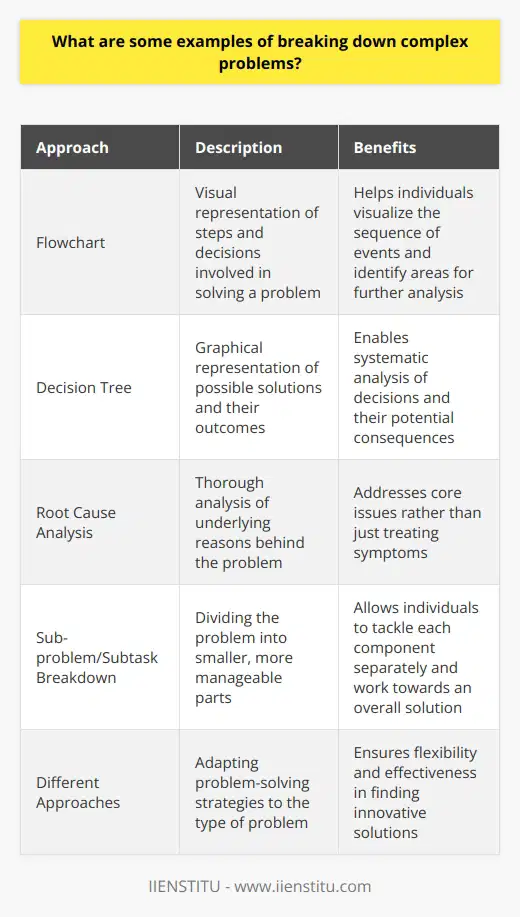
How do you develop complex problem solving skills?
**Understanding Complex Problem Solving**
To develop complex problem solving skills, one must first understand the nature of complex problems. These problems typically involve multiple variables, interconnected parts, and unpredictable outcomes, requiring a deep understanding of the underlying systems.
**Skill Acquisition through Practice and Experience**
The acquisition of complex problem solving skills can be achieved through practice and experience. By engaging in diverse problem-solving activities, individuals can develop a repertoire of mental models and strategies that can be applied across different contexts. It is essential to reflect on past experiences and analyze the effectiveness of the employed strategies in order to refine one's problem-solving process.
**Cultivating Critical Thinking**
Critical thinking is crucial for complex problem solving, as it enables individuals to identify and evaluate potential solutions while considering long-term implications and consequences. This requires a willingness to question assumptions, challenge conventional wisdom, and remain open to new perspectives. Encouraging a critical mindset can involve engaging in debates, discussions, and analyzing divergent viewpoints on various issues.
**Developing Creativity and Adaptability**
Complex problem solving also necessitates creativity and adaptability, as it often requires generating multiple solutions and adjusting strategies in response to new information or changes in context. Fostering creativity can involve engaging in brainstorming exercises, exploring unconventional ideas, and experimenting with different methods to solve a given problem. Developing adaptability entails being open to change, responsive to feedback, and capable of switching approaches when necessary.
**Leveraging Collaborative Efforts**
In many cases, complex problems are most effectively addressed through collaboration, as diverse perspectives and expertise can yield comprehensive and innovative solutions. Developing these skills often involves participating in group projects, sharing knowledge, and building networks with other professionals in relevant fields. It is important to learn how to listen effectively and communicate clearly, as well as to respect and appreciate the contributions of others.
**Utilizing Technology and Tools**
Lastly, it is crucial to leverage technology and tools to enhance complex problem solving capabilities. Technological advancements have paved the way for a myriad of resources, such as simulation software, data analysis tools, and interactive platforms that can assist in understanding complex systems and generating solutions. Familiarity with these tools and the ability to apply them effectively in problem-solving scenarios can greatly enhance one's skills in tackling complex issues.
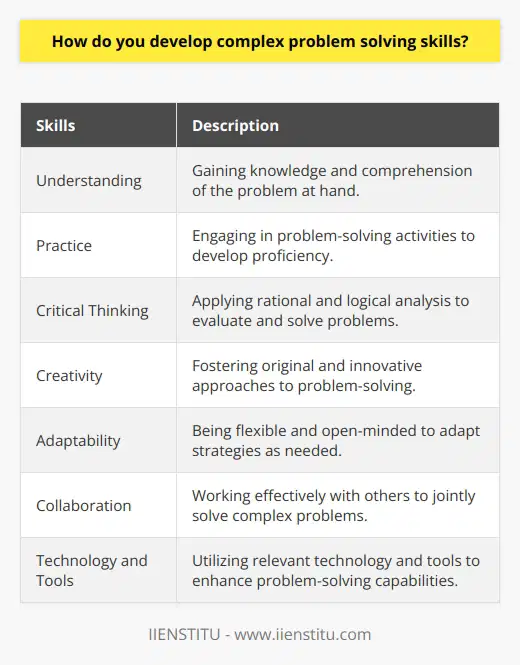
What is the process of breaking down a complex problem?
Understanding the Process
The process of breaking down a complex problem involves several steps that enable individuals or groups to comprehend, analyze, and resolve intricate issues. This technique simplifies the problem by dividing it into smaller, more manageable parts.
Identifying the Problem
Firstly, it is crucial to clearly define and understand the problem. This involves identifying the main issue and recognizing its complexity. It is essential to discern the scope of the problem and determine the necessary resources to address it.
Dividing the Problem
Next, dissect the problem into smaller components or sub-problems. These components should be more straightforward and easier to handle, ideally independent of each other. This division enables a systematic approach to solving the larger problem by tackling each component one by one.
Analyzing Each Component
Once the problem is divided, carefully analyze each component to determine its significance and impact on the overall problem. Investigating each sub-problem also helps in identifying any underlying patterns or connections that may exist, providing a clearer understanding of the complex issue.
Establishing Priorities
After analyzing each sub-problem, assign a priority level based on its significance and impact on the larger problem. Prioritization helps to allocate resources effectively and focus on the most critical sub-problems first, ensuring a more efficient resolution of the overall issue.
Developing Solutions
With a clearer understanding of the sub-problems and their priorities, develop feasible solutions to address each component. These proposed solutions should take into account the resources available and the expected outcomes. It is also vital to examine potential consequences and account for any unforeseen variables.
Implementing Solutions
Once solutions are in place, carefully implement them while monitoring their progress and impact on the sub-problems. Close monitoring allows for adjustments and revisions as needed, ensuring an effective resolution of the issue. It also helps in identifying any further complexities that may emerge as a result of implementing the solutions.
Evaluating Outcomes
Finally, evaluate the outcomes of the implemented solutions and assess their effectiveness in resolving the complex problem. This step provides valuable insight into the success of the problem-solving process and helps in refining future strategies for addressing similar complex problems.
In conclusion, breaking down a complex problem into manageable parts allows for a more systematic and efficient approach to resolving it. By understanding, dividing, and analyzing the problem, prioritizing its components, and implementing and evaluating solutions, individuals and groups can successfully address and overcome complex issues.
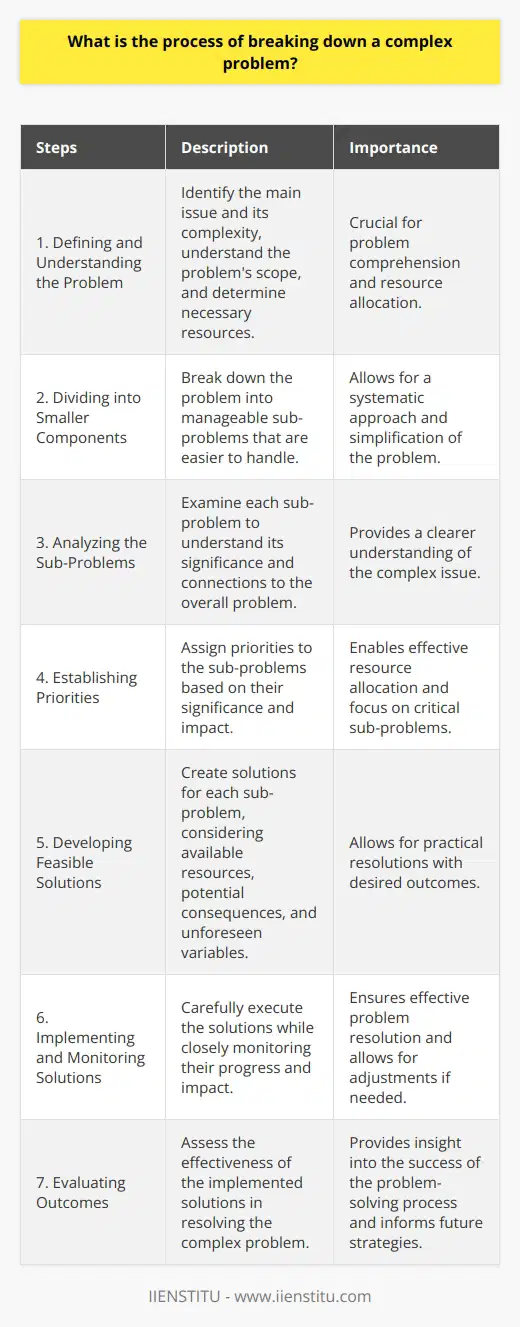
What are complex problems in problem solving?
Defining Complex Problems
Complex problems in problem-solving refer to multifaceted issues that cannot be easily solved using simplistic approaches. These types of issues often have various interconnected aspects, making it challenging for individuals or groups to develop a single, straightforward solution.
Characteristics of Complex Problems
One key aspect of complex problems is uncertainty. Due to the numerous interrelated factors and dynamic environments, it becomes difficult to predict the specific consequences of a solution. This may result in unintended outcomes or create new issues.
Another characteristic is ambiguity. Solving complex problems can involve multiple interpretations, as there may be no clear definition or consensus on the nature of the problem itself. This can lead to conflicting perspectives on the best approach to resolve the issue.
Complex problems are also often persistent or recurring, making it necessary to approach them in a dynamic and adaptive manner. This requires ongoing monitoring and refinement of the proposed solutions to ensure their sustained effectiveness.
Strategies for Addressing Complex Problems
Approaching complex problems requires adopting systematic and collaborative strategies. One such strategy is the use of interdisciplinary teams. By incorporating experts from various fields, diverse perspectives and knowledge can be leveraged to develop more comprehensive solutions.
Another strategy involves adopting a systems-thinking mindset. This takes into consideration the interconnected nature of the problem and its various components, helping to identify potential leverage points and interdependencies.
The use of iterative processes and adaptive management can also be effective in tackling complex problems. This approach involves implementing solutions in an incremental manner, monitoring their impact, learning from the results, and continuously refining the strategy.
In conclusion, complex problems in problem-solving pose significant challenges due to their multifaceted, uncertain, and dynamic nature. A combination of interdisciplinary teamwork, systems-thinking, and adaptive management can lead to more effective strategies for addressing these difficult issues.

What is the breakdown of problem solving skills?
Understanding Problem-Solving Skills
To answer the question on the breakdown of problem-solving skills, we must first understand what these skills entail. Problem-solving skills refer to the cognitive and practical abilities individuals employ in resolving complex issues, making decisions, and finding efficient solutions.
Cognitive Skills
Cognitive skills play a significant role in problem-solving, as they provide mental tools to analyze and understand the situation. These skills primarily focus on the following aspects:
Analysis: The ability to identify the problem and break it down into smaller components is crucial for successful problem-solving. This process aids in understanding the core issue, underlying causes, and potential implications.
Critical Thinking: After analyzing the problem, it is essential to evaluate possible solutions using logical reasoning and deductive skills. Critical thinking helps to differentiate between effective and ineffective strategies, ensuring an optimal solution.
Creativity: Generating innovative solutions often requires creative thinking skills. This involves brainstorming new ideas, making connections between seemingly unrelated concepts, and exploring alternative approaches.
Practical Skills
In addition to cognitive skills, practical skills are also necessary for effective problem-solving. These skills revolve around the following concepts:
Decision-Making: Once potential solutions are identified and evaluated, a decision must be made to choose the most suitable approach. This process involves comparing the pros and cons of each option and selecting the best course of action.
Communication: Effective problem-solving often relies on collaboration and sharing ideas with others. Strong communication skills allow individuals to convey their thoughts clearly and persuasively, facilitating understanding among team members.
Adaptability: Solving problems may require altering strategies or changing perspectives, especially when confronted with new information or obstacles. Adaptability enables individuals to respond effectively to changing circumstances and apply different methods when necessary.
Problem-solving skills are a combination of cognitive and practical abilities that enable individuals to tackle complex problems and arrive at efficient solutions. Developing these skills requires focused attention on various cognitive aspects, such as analysis, critical thinking, and creativity, as well as practical aspects, including decision-making, communication, and adaptability. Strong problem-solving abilities contribute to professional success and personal growth, as individuals become more capable of navigating challenges and generating effective solutions in various areas of life.

How can interdisciplinary approaches contribute to solving complex problems?
Integrating Perspectives for Holistic Solutions
Interdisciplinary approaches can contribute significantly to solving complex problems by bringing together diverse perspectives, tools, and methods from different disciplines. By integrating knowledge and skills from various fields, interdisciplinary approaches can offer more comprehensive, holistic, and effective solutions that address multiple dimensions of a problem.
Collaborative Thought Processes
For instance, solving environmental problems often requires collaboration between scientists, policy makers, and other stakeholders. An interdisciplinary team can not only conduct research in their respective fields, but also synthesize findings, cross-pollinate ideas, and catalyze innovative thought processes. This intellectual collaboration helps to create more nuanced understanding of complex issues and fosters creative problem-solving techniques.
Mutual Learning and Adaptation
Moreover, interdisciplinary approaches support mutual learning processes and adaptability among team members. As individuals gain insights and knowledge from their counterparts in different fields, they can apply new perspectives to their own areas of expertise. This continuous exchange of ideas and knowledge enhances the overall capacity of the project team to address multifaceted problems.
Lessons from Real-world Cases
A well-known example of interdisciplinary approaches in action is the field of public health, where medical experts, social scientists, and public policy analysts work together to combat infectious diseases, address healthcare disparities, and promote preventive care. By combining clinical, socioeconomic, and policy perspectives, public health practitioners can create comprehensive strategies and interventions that improve population health outcomes.
Other examples of interdisciplinary problem-solving can be found in areas such as urban planning, where architects, engineers, social scientists, environmental experts, and other professionals collaborate to create sustainable, resilient, and inclusive cities.
Overcoming Obstacles Together
Despite the promising potential of interdisciplinary approaches, various challenges might arise, such as communication and coordination barriers among team members with divergent backgrounds. To harness the full potential of interdisciplinarity, it is crucial to invest in building effective communication channels, trust, and mutual understanding.
In conclusion, interdisciplinary approaches can provide crucial benefits in addressing complex problems by incorporating diverse viewpoints, fostering innovation, and promoting mutual learning. By overcoming potential obstacles, interdisciplinary teams can leverage their combined expertise to develop holistic and effective solutions for today's pressing issues.
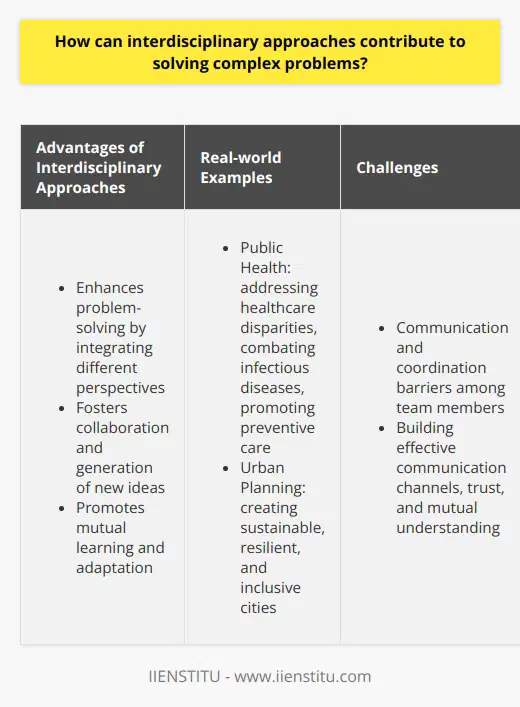
How do mental models and cognitive biases affect our ability to solve complex problems?
Mental Models in Problem Solving
Mental models are cognitive structures that represent our understanding of the world around us. They help to simplify complex scenarios by allowing individuals to organize and process information efficiently. However, these models can negatively impact our ability to solve complex problems when they cause oversimplification or incorrect assumptions due to a lack of accurate or complete information.
Cognitive Biases Impact on Decision Making
Cognitive biases are systematic patterns of deviation from normative reasoning, which can distort our perception and judgment. These biases can interfere with our ability to effectively solve complex problems by skewing the information we deem relevant or by causing us to make decisions based on emotion rather than logic. For example, confirmation bias can lead individuals to seek information that supports their pre-existing beliefs while disregarding contradictory evidence, hindering the development of accurate mental models necessary for effective decision-making.
Addressing Mental Models and Cognitive Biases
In order to mitigate the negative effects of mental models and cognitive biases on problem-solving, individuals should engage in critical thinking and continually question their assumptions. This can involve seeking out diverse perspectives, considering multiple solutions, and reflecting on possible biases in the decision-making process. Additionally, cultivating a growth mindset can help individuals remain open to new information and adapt their mental models accordingly, leading to more effective problem-solving strategies.
